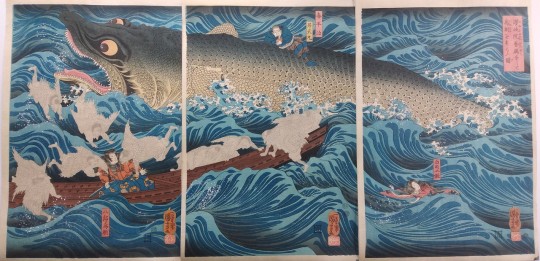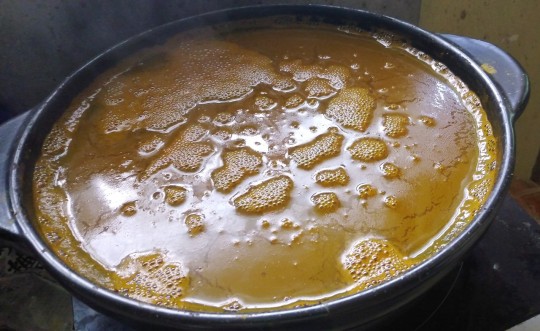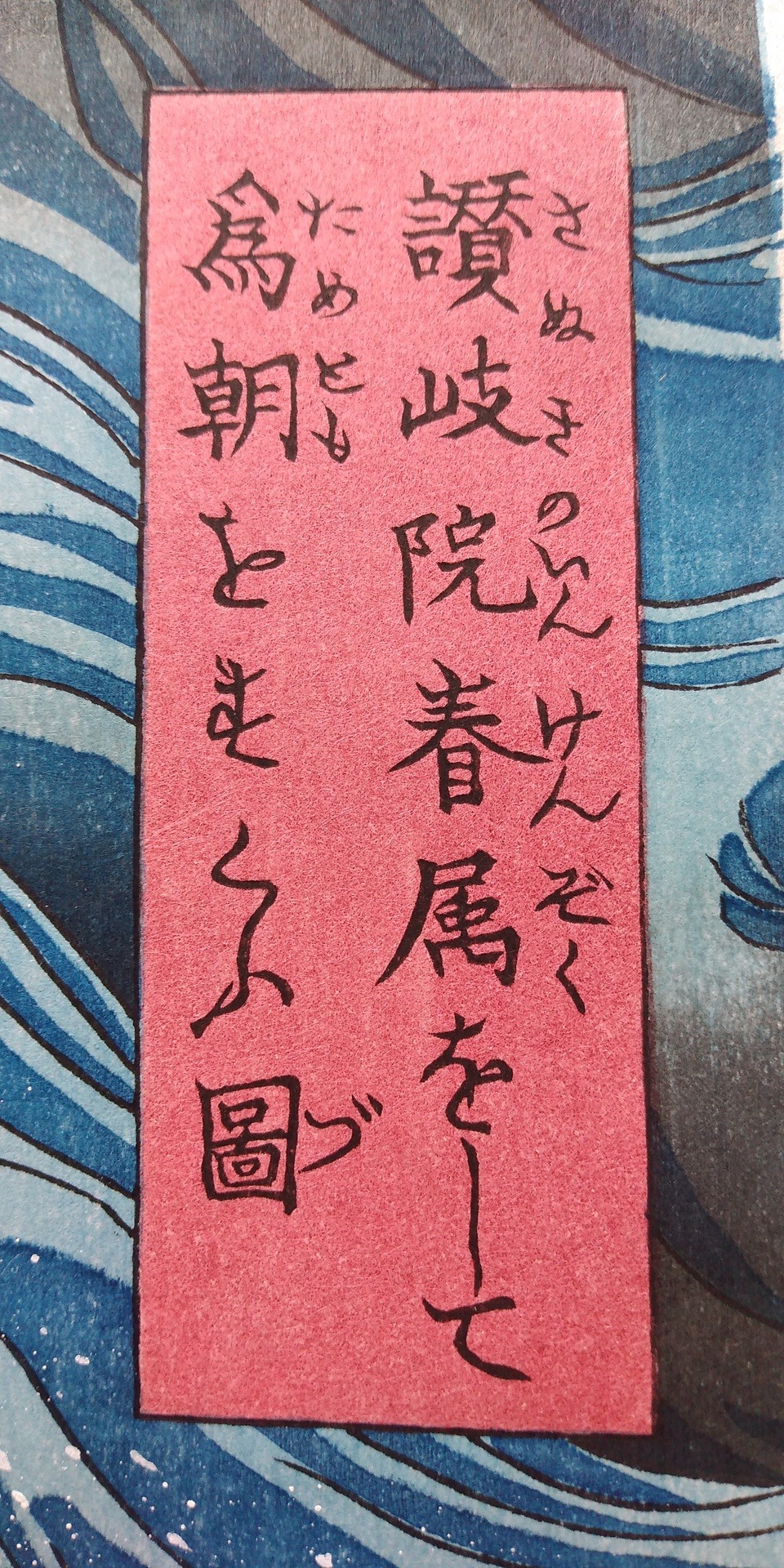#i haven't done ph adjustment in so long
Text

struggling in the lab today
9 notes
·
View notes
Text
Description pt1

"This is one of the extravagantly heroic compositions produced by Kuniyoshi in response to the government crack-down on more frivolous subjects. It is based on the novel by Kyokutei Bakin (1767-1848) 'Chinsetsu Yumiharizuki' and Hokusai's illustrations to it. Fleeing by sea from defeat in the Heiji Wars, Tametomo's party are overcome by a storm. His wife throws herself into the sea to placate the waves, while Kihei saves their child by climbing on to the back of a huge shark. Tametomo is stopped from killing himself by the spirits of mythical creatures called 'tengu', followers of the dead Emperor Sutoku. The signature is 'Painted by Ichiyusai Kuniyoshi'."
Smith
1988
:refered from the British Museum's website.The original resource is in, https://www.britishmuseum.org/collection/object/A_1906-1220-0-1339
ーAbout the original copy I usedー
In the case like this time that I never can get the true original print, Im usually to use the old reproduction or printed matter from a book or internet.
Since a reproduction print is normally difference from the original in the all point of lines, colors, etc.,so it's better to use a printed matter of the original print. However, I couldn't get to find the good copy of this one on books or databases of the internet. Those that were available there were not in good condition or too downsized that I couldn't use at all.But on the way I had been looking for, I in chance could find the old reproduction in the market. So I decided to buy and reproduce from that one since there hadn't seemed other way except that .The reproduction of this picture is really rare itself. It's highly probable that there have been ever just two reproductions .The one is by Inuki Tachihara and the other is by a publisher, Uchida Art. The reproduction I got was that Inuki Tachihara had reproduced in 1987. When I compared the print with the original copy as possible as I could after buying , there were not a few points of lines , colors, etc.,which were difference from the original in the edo period.But I decided to choose to refer only the Tachihara's reproduction for my reproducing work since making half adjustment and taking on half way to the original print without the good original copy made me feel something strange or inconsistentable.
So my this time reproducing work is reproducing of reproduction.
This is the reproduction by Inuki Tachihara in 1987, which I used as the original copy for this time .

(It's normal that a reproduction print has difference points from the original true print.Because it's impossible to make the exactly same print as long as it's handmade and reproducing basically haven't been aimed to pursue to reproduce the exactly same state of the original print in its history.For example, reproducing resembles classical music or entertainment. What I mean is that the player's aiming isn't to pursue reproducing exactly the same state of the first of the original era.But unlike the music or entertainment, there is the field of restoration in paintings. What Ive been aiming belongs the kind of there. Hopefully, I want that reproducing and restoring of ukiyoe will be separated to recognize a little more clearly as difference work in each, in people even including a traditional carver, printer or publisher.)
In the following link, you can look some original copies and the reproduction by Uchida Art. https://ukiyo-e.org/image/bm/AN00027972_001_l
Anyway, although Inuki Tachihar already died but he was the only guy who had done reproducing including materials restoration.Im going to post an article to introduce him here my blog in the near future.
ーThe materialsー
①woodblock : I for this reproducing used 16 pieces of plywood of cherry, Yamazakura山桜 , which its dimension is 27×40×2.5㎝ in each piece.

②pigment
Finding out and restoring the original pigment and paper are the important theme of my work.I have an idea that one of the main reasons why a reproduction commonly doesn't make me feel the reality of original print is the difference of use of pigments and paper between the reproduction and original . For example, there is not a few vintage reproductions which don't look to come to get closer to the original though they've already gotten quite aging change.I think this is also caused by the difference of materials .The pigments I used for this reproducing were sumi, turmeric, mercury vermilion, red iron oxide, prussian blue, safflower red, white lead and mica powder. I explain as the following some of them.I yet haven't gotten satisfied ones, but want to find and get someday in the future.
・turmeric

Printed turmeric color tends to permeate to the backside of sheet ,so I could distinguish the use from the backside of his reproduction. Mr. Tachihara basically had made the pigment of turmeric by drying its color extraced from the root by boiling .I this time followed that way. However, in the book published in the meiji period, it's written that the color is extrcted by boiled water or alcohol, etc. Actually, it hasn't yet been clear how it had been made in the edo period. Anyway, in the field of dying, changing the color by the use of some kinds of mordant have been done from the quite old days, so I think there is possibility that the turmeric pigment at a supply store in the edo may haven't been one kind. Hopefully, I in the future could find a materials book which provides evidence but I feel that probably couldn't be verified without doing scientific analysis for the pigment on the original prints in good condition.Anyway, the turmeric on his reproduction has a little more red color than mine. But since the turmeric is easy to get changing by aging and when I before time left its ingredient after using , it got red color , so I this time figured the red color of turmeric of his reproduction was caused by aging.(Although this isn't a case of this time, the turmeric color get the red color a little bit by being deepen. ) The color of turmeric is easy to be gotten since once it's boiled in water,the color comes out soon. However, the times of boiling we do, the color endlessly comes out being paler by paler like as a tea pack. How I could do extracting effectively had been a problem I had in these years, but I this time could find better way for that.I'll introduce that way in the future post.
・safflower red 細工紅

The red color of safflower can be gotten from hana-mochi紅花餅 which is dried petals of safflower after fermented , by alkali liquid from straw ash and acid from plum.For using as pigment, that dried color is dissolved by acid from plum.Since I hadn't been able to make this pigment well , I concentrately was doing experiments many times to make the good pigment in almost a couple of months for this time.As the result, I succeeded to make much better one than before. Although I think there isn't one true color of this pigment as restoring the one over 150years ago since the pigment color on making progress is changeable by the various reasons like the quality of ingredient, making method, climate condition or ph of the plum acid which is added as the use of pigment. But I this time could make the good one reaching the range of level being aimed.
According to the book "nishiki-e no hori to suri"錦絵の彫と摺written by Kendou Ishii石井研堂, as the use of safflower red pigment , acid from dried peeled plum called "kawa-muki"皮むき is used to dissolve the pigment. I this time tried to make and used it as just plum's season.

I'll post more detailed info of this pigment in the near future.
I was so impressed the red color when I printed it .Although I'd been using a red pigment of chemical carmine for a reproducing work from publisher or my second state work, which has been generally used in the traditional printers but I thistime realized deeply that the safflower red pigment looked similar but actually different from the chemical carmine.

Anyway, when Mr. Tachihara reproduced this in 1987, he didn't yet found the true safflower red pigment 細工紅. Reading his books , I think he had used the other kind of safflower red pigment called hon-beni 本紅 which was purer and made mainly for a lipstick from safflower petals.
・red iron oxide

It's said two kinds of red iron oxide had been used in the original prints in the edo period.I have made one of them by my self . However, the color on Mr. Tachihara's reproduction had much more red and dark than mine , so I this time used to mix my self made one with sumi and a ready made red irono xide sold with name of "natural soil", which had more red color .Although I don't know what kind of red iron oxide he used in his reproduction , but probably it would have been natural one from soil.
・mica

Mica powder was used mixing with other pigments for the colors of gradations on the huge shark or the waves. When I was a traditional printer, I had used ready made one. But I feel particle of those ready made ones are homogeneous and refined too much , and I didn't like much to use for my own reproducing .So , on this occasion that I used mica powder for my own one in the first time, I thought to try to make it by myself. In the beginning, I started to look for the natural domestic mineral on the internet, but run into difficulties.So I went to the mountain in Aichi prefecture, where had been the famous place of the production in the past.The mica I used for this reproducing was that I had gotten there and refined by myself. I'll introduce more detailed info of that in the near future post .
To be continued Description pt2.
1 note
·
View note